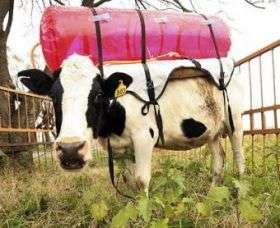July 11, 2008 weblog
Cow Backpacks Trap Methane Gas

(PhysOrg.com) -- In an attempt to understand the extent of cow flatulence on global warming, scientists in Argentina are strapping plastic bags to the backs of cows to capture their emissions.
Argentina has more than 55 million cows, making it a leading producer of beef. In the study, the scientists were surprised to discover that a standard 550-kg cow produces between 800 to 1,000 liters of emissions, including methane, each day.
Further, methane - which is also released from landfills, coal mines and leaking gas pipes - is 23 times more effective than carbon dioxide at trapping heat in the atmosphere.
"When we got the first results, we were surprised," said Guillermo Berra, a researcher at the National Institute of Agricultural Technology in Argentina. "Thirty percent of Argentina´s (total greenhouse) emissions could be generated by cattle."
In their study, the researchers attached balloon-like plastic packs to the backs of at least 10 cows. A tube running to the animals´ stomachs collected the gas inside the backpacks, which were then hung from the roof of the corral for analysis.
The Argentine researchers say that the slow digestive system of the cows causes them to produce these large amounts of methane. Now, the scientists are performing trials of new diets designed to improve the cows´ digestion and reduce global warming. By feeding cows clover and alfalfa instead of grain, "you can reduce methane emissions by 25 percent," according to Silvia Valtorta of the National Council of Scientific and Technical Investigations.
via: Reuters





















